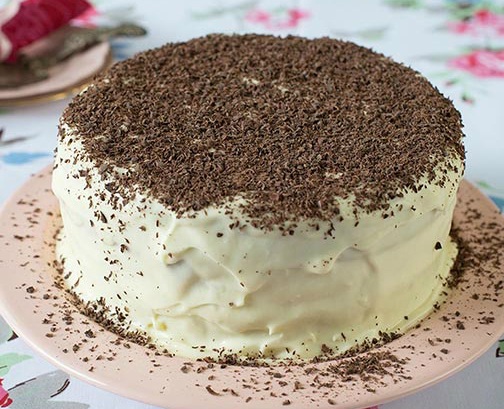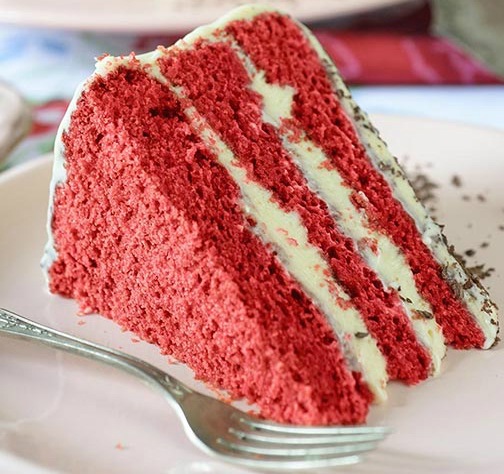There's no better way to treat a friend or loved one than with a lovely homemade cake, especially one you baked yourself. But if you're new to baking and aren't sure exactly how to bake a cake from scratch, fear not. Our guide will outline everything you need.

Step 1: Grab your Recipe
First you’ll need to find a particular cake recipe. We recommend starting with something you like, but you’ll want to keep it relatively simple (don’t try tackling that multi-tiered dream wedding cake just yet!). A classic sponge cake, carrot cake or chocolate cake is usually a good place to start. We’re going to use our Red Velvet Cake recipe as example throughout this guide, because it’s popular, delicious and not overly complicated.
Whichever recipe you choose, make sure you follow it to a tee. There’s a reason people describe baking as a science. Even the slightest over or underuse of an ingredient, or improper technique (eg stirring instead of whisking) can make your cake too flat, too dense, too moist, too removed from that wonderfully-textured delicious cake you’re aiming to make. Be meticulous!
Step 2: Grab your Utensils
Different recipes call for different utensils, but generally speaking, you’ll require:
Cake pan(s): Most cake recipes require the use of cake pans. Our Red Velvet cake, for example, requires 3 x 8-inch pans. Be sure to use the same size and amount of pans as specified in your recipe. A cake increases in volume during baking, so using a smaller pan could result in overspilling, while a pan that’s too big may cause the cake to lose shape.
Oven: Make sure your oven is calibrated correctly (you can use an oven thermometer to check its temperature). Unless your recipe specifies otherwise, it's best to bake your cake in the center of the oven to avoid the risk of overcooking.
Wooden Spoon
A highly innovative, all-purpose stirring device.
Scales
While measuring spoons can be accurate (at least compared to regular teaspoons and tablespoons), we generally recommend using scales for your baking measurements. Some ingredients are denser than others, and only through a precise measurement of weight can you ensure you're using the correct amount.
Rolling Pin
Perhaps the baker's simplest yet most time-tested tool, as valuable as it was centuries ago, a rolling pin is particularly helpful when trying to roll out even shapes from your dough.
Sieve
Use this to sift out flour and other granular ingredients to ensure there are no clumps. Clumps = ruined cake!
Baking Parchment
This non-stick paper can be a godsend. By lining your trays and pans with it, you can move your cake without it falling apart or sticking to sides.
Whisk
A whisk creates bubbles of oxygen in your ingredients, giving them bounteous volume and texture. A food mixer can also be used in this case.
Step 3: Grab your ingredients

Most basic cake ingredients can be obtained at your local grocery store, but you may find it easier to buy ingredients online. We sell lots of baking products here at Gourmet Food World, including baking chocolate, fruit purees and sugar.
Here are some of the most common ingredients for baking a cake from scratch:
Flour: Flour is the thickening agent that will provide gluten to your cake batter. There are several different types of flour, and each will result in a different consistency. All-purpose flour is most common, and produces medium-density, soft cakes. Cake flour yields light, airy cakes such as Angel Cake, while bread flour is much denser and better-suited to baking bread (though you can combine it with all-purpose if you want a slightly chewier cake).
We also recommend weighing your flour rather than using measuring cups, for the simple reason that it’s more accurate (and thus more sciency!).
Leavener: this is the “lifting” component that creates bubbles of carbon dioxide that cause the cake to rise. It will usually be baking soda or baking powder (these may sound similar but are in fact different ingredients and should not be used interchangeably).
Fat: Fats provide moisture for the cake and usually come in the form of butter, milk, cream and/or oil.
Eggs: while not used in all cakes, eggs are great for their natural emulsifying effect, holding the ingredients together and maintaining a balanced consistency.
Sugar: As well as adding sweet flavor to your cake, sugar absorbs moisture to keep the cake from drying out, and it also caramelizes during cooking, creating that nice browning effect.
Other ingredients: Many recipes call for extracts, flavors and seasonings, which may include: vanilla, cocoa, cinnamon, syrup, salt or fruits. Unless otherwise stated, try to go with real, authentic versions and not imitations.
Step 4: Start baking
Grease your Pans: To prevent the cake from sticking, you'll want to grease the pans first. Spread a dollop of butter around the bottom and sides of each pan should, or use cooking spray. Lightly dust the pans in flour. You can also line the pans with parchment paper, making it easier to pull the cakes out. If it’s not already non-stick, be sure to grease the paper so you don't have to spend hours peeling paper pieces off of your cake!
Mix your batter: Follow your recipe closely, adding ingredients in the correct order and using the exact techniques suggested. For example, our Red Velvet Cake recipe requires the use of a sieve to sift the ingredients and avoid clumps. You may wish to use electric appliances such as a hand-mixer for more effective results. Spread your mixture evenly into your pans so it’s ready for baking.
Baking: Always make sure you preheat your oven so that you can put the batter in straight away. Wait too long and it may lose its consistency. Bake according to your recipe’s instructions. If you’re not using a convection oven, you may need to rotate the pans halfway through baking so that the cake cooks evenly.
Frosting: If your cake includes frosting, prepare it while your cakes are baking. Again, follow your recipe closely, then put the frosting to one side while you wait for the cake to finish baking.
Cool down: When the cake appears fully baked, try sticking a toothpick in it. If it emerges dry then your cake should be cooked all the way through to the middle. You can also gently prod the cake with your finger. If it’s firm but bouncy, it should be done. Now remove the cake and let it cool for around 15-20 minutes before frosting. Use a knife or spatula to help unstick the cake from the pan (or you can pull it out via the parchment paper if you placed some in there earlier).
Applying the frosting: When the cake is cool, dab some frosting underneath it so it sticks and stays in place. You may also want to place it over parchment paper so that any loose crumbs don’t spill onto your plate. If your cake has multiple layers, apply your first frosting to the top of the bottom layer using an offset spatula. Make sure it’s even, then place your next layer on top and repeat until you have one more layer left. When all layers are piled on top of one another, you’re ready to apply the outer frosting. Start by applying a thin layer of frosting before placing the cake in the fridge to cool down for 20 minutes. Then take it out and apply a much thicker layer of frosting. Then apply any other decorations required (like chocolate sprinkles on our Red Velvet cake), and your cake is ready to slice, serve and devour. Or, if you want to save for later, wrap in plastic and store in the fridge or freezer.
Save